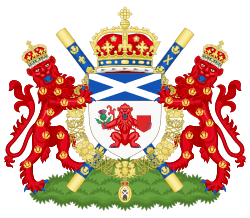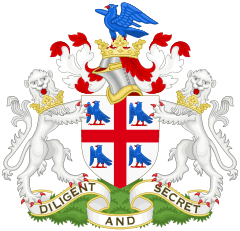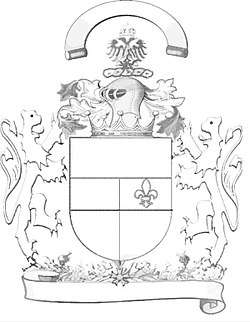Heraldic authority
A heraldic authority is defined as an office or institution which has been established by a reigning monarch or a government to deal with heraldry in the country concerned. It does not include private societies or enterprises which design and/or register coats of arms.
Over the centuries, many countries have established heraldry authorities, and several still flourish today.
Europe


Belgium
- Raad van Adel or Conseil de la noblesse (Council of the Nobility) (1844– ) – grants arms to the nobility and municipal arms in the German Speaking Community of Belgium.
- Vlaamse Heraldische Raad (Flemish Heraldic Council) (1984– ) – supervises and advises the Flemish Government regarding grants of non-noble personal, official, municipal, and corporate arms within the Flemish Community of Belgium.
- Conseil d'héraldique et de vexillologie de la Communauté française de Belgique (Heraldic and Vexilological Council of the French Community of Belgium) (1985– ) – grants non-noble personal and municipal arms in the French Community of Belgium.
Burgundy
- Toison d'Or King of Arms (1430–83)
Croatia
- Ministry of Public Administration - Commission for approving the coat-of-arms and flags to the local self-government units
The commission deals only with municipal heraldry and vexillology. It is composed of five members appointed on a four years mandate by the Minister: jurist, heraldist, archivist, historian and visual artist.[1] Pursuant to article 10. Law on the local self-government units, all municipal coats of arms have to be made and blazoned in accordance with heraldic rules.[2] Ministry will issue armorial (Croatian: grbovnica) to municipality in the form of a booklet composed of 8 pages. The Armorial is made in three copies of which one is obtained by : unit of local self-government, Croatian State Archives and the Ministry of Public Administration.
Czech Republic
- Chamber of Deputies of the Parliament of the Czech Republic – Subcommittee on heraldry and vexillology
The subcommittee deals only with municipal heraldry and vexillology. The grants of arms approved by the committee are signed by the Speaker of the Chamber of Deputies. The Czech Republic has no heraldic authority for personal arms.
Denmark
- Statens Heraldiske Konsulent (State Heraldry Advisor) (1938– ). The National Archives of Denmark is the State Heraldry Advisor since 1985.[3]
Finland
- Heraldinen lautakunta (Heraldic Board), founded in 1957, known 1957–88 as Heraldinen toimikunta (Heraldic Committee).[4] It operates as a part of the National Archives of Finland.[5]
France
- College d'armes (1407–1790)
Georgia
- State Council of Heraldry (2008–present)
Germany
Holy Roman Empire
- Reichsherold (Imperial Herald) (1520-?)
Bavaria
- Reichsherold (Royal Herald) (1808–1920)
Prussia
- Oberheroldsamt (1706–1713) – dealt with noble and municipal arms.
- Königlich Preussisches Heroldsamt (Royal Prussian Heraldry Office) (1855–1920)
Saxony
- Kommissariatt für Adelsangelegenheiten (Commission for Noble Affairs) (1902–1920)
Ireland
- Ulster Office (1552–1943), headed by Ulster King of Arms.
- Genealogical Office (1943– ), headed by the Chief Herald of Ireland and forming part of the National Library of Ireland – grants personal, official, municipal, and corporate arms.
Italy
- Consulta Araldica (Heraldry Council) (1869–1947)
- Ufficio Cerimoniale della Presidenza del Consiglio dei Ministri (since 1947) [6]
Latvia
- State Heraldry Commission (1997– ), forming part of the Presidency – deals with official and municipal arms.[7]
Lithuania
- Heraldry Commission (1988– ),[8] forming part of the Presidency – deals with official and municipal arms.
Luxembourg
- Commission héraldique de l'Etat (State Heraldic Commission)
Netherlands
- Hoge Raad van Adel (High Council of the Nobility) (1815– ) – grants personal arms (to nobles only) and official, military, and municipal arms. Also provides advice regarding arms of members of the royal family.
Norway
- Ministry of Foreign Affairs – all matters concerning the Coat of arms of Norway (Norwegian: Riksvåpenet = Coat of arms of the realm)
Poland
- Komisja Heraldyczna (Heraldic Commission)
Portugal
- Cartório da Nobreza (Nobility Register) (1521 - 1910) - heraldic authority for the Kingdom of Portugal;
- Secção de Heráldica da Associação dos Arqueólogos Portugueses (Heraldic Section of the Association of Portuguese Archeologists) (1930 - ) - heraldic authority for the municipalities of Portugal;
- Gabinete de Heráldica Corporativa (Office for Corporate Heraldry) (1930 – 1974) – heraldic authority for the corporative arms;
- Gabinete de Heráldica do Exército (Office for Army Heraldry) (1969 - ) - heraldic authority for the Portuguese Army;
- Gabinete de Heráldica Naval (Office for Naval Heraldry) (1972 - ) - heraldic authority for the Portuguese Navy;
- Gabinete de Heráldica da Força Aérea (Office for Air Force Heraldry) (1977 - ) - heraldic authority for the Portuguese Air Force;
- Gabinete de Heráldica Autárquica (Office for Municipal Heraldry) (foreseen in 1991, but never created) – heraldic authority for the municipalities of Portugal.[9]
Russia
- Office of Heraldry (1722–1917), headed by the Master Herald – granted personal, official, and municipal arms.
- Heraldic Council of the President of the Russian Federation or State Heraldry Service (1992– ), headed by the Master Herald and forming part of the President's Office.
Slovakia
- Heraldic Commission
- Heraldic Registry of the Slovak Republic (part of Ministry of Interior)[10]
Spain
- Cronistas de Armas (Recorders of Arms), established in 1496. (For provinces of Castile and León only.)
Sweden
- Riksheraldiker (National Herald) (1734–1953)
- Statens Heraldiska Nämnd (State Heraldry Office) (1953– ), headed by a State Herald, and forming part of the Royal Archives. registered with the Swedish Patent and Registration Office (Patent- och registreringsverket or PRV). Only official arms (royal and civic arms) are handled. Burgher and commoner arms are less strictly controlled and may be recognized by publication in the annual Scandinavian Roll of Arms.
United Kingdom
England and Wales
- College of Arms (1484- ), headed by the Garter Principal King of Arms, under the general jurisdiction of the Earl Marshal – grants personal, municipal, and corporate arms, also records pedigrees and genealogies.
Northern Ireland
- Until 1943, Northern Ireland came under the Ulster Office; since then, it has fallen under the College of Arms part of the jurisdiction of the Norroy and Ulster King of Arms which also covers the counties of England and Wales North of the River Trent.
Scotland
- Court of the Lord Lyon, headed by the Lord Lyon (c. 1399?- ) – grants personal, municipal, and corporate arms; it is illegal to bear arms in Scotland unless they have been granted or recorded by the Lord Lyon.
Africa
Kenya
- Kenya College of Arms (1968– ), headed by a Registrar, and forming part of the Attorney-General's Office – grants and registers personal, municipal, and corporate coats of arms. It was established by the College of Arms Act of 1968.
South Africa
- Department of the Interior (1935–1959) – inter alia registered the arms of associations and institutions, as "badges".
- Provincial administrations (1949–1963 – inter alia registered the arms of municipalities in their respective provinces.
- Department of Education, Arts & Sciences (1959–1963 – inter alia registered the arms of associations and institutions, as "badges".
- Bureau of Heraldry (1963– ), headed by the National Herald (formerly State Herald), and forming part of the National Archives & Records Service – registers personal, official, military, municipal, and corporate arms. Together with the Heraldry Council, it forms part of the National Archives and Records Service (formerly called the State Archives Service), which is currently under the authority of the Minister of Arts & Culture.
The Heraldry Act 1962, which governs the Bureau of Heraldry, has not been changed to replace "State herald" with "National Herald"[11]. Announcements in the Government Gazette of South Africa still use "State Herald".
Zambia
- Colours Control Board (1958– ) – inter alia registers the arms of associations and institutions, as "badges".
Zimbabwe
- Registrar of Names, Uniforms, Badges and Heraldic Representations (1971– ), forming part of the Patents Office – registers official, municipal, corporate, and personal arms.
Bunyoro-Kitara, Uganda
- Heraldry Society of Africa (2016- ), forming a repository of historic and current heraldry within the sub-monarchy of Bunyoro-Kitara, and all of the continent of Africa, and as warranted abroad.
Asia
Azerbaijan
- Heraldic Council (2006– ), forming part of the Presidency.
Georgia
- State Council of Heraldry at the Parliament of Georgia (established in 2008)
Philippines
- Philippine Heraldry Committee (1940-1972) – government coat of arms, seals, and other symbols of state
- National Historical Commission of the Philippines (1972-) – absorbed responsibilities of the Philippine Heraldry Committee after the Reorganization Act of 1972. Final approval of works required from the Office of the President
North America
Canada
- Canadian Heraldic Authority (1988– ), headed by the Chief Herald of Canada, and forming part of the Governor General's Household – grants personal, official, military, municipal, and official arms.
United States
- Carolina Herald was an English herald responsible for heraldry in Carolina in early and mid 18th Century colonial times.
- United States Army Institute of Heraldry (1920– ) – responsible for military heraldry, also provides heraldic services to the federal government.
Oceania
New Zealand
- New Zealand Herald Extraordinary (1978– ) in the Governor-General's Household – represents the English College of Arms.
References
- ↑ "Pravilnik o postupku davanja odobrenja grba i zastave jedinici lokalne samouprave" [Regulation on the procedure for granting the coat of arms and flags to the local self-government unit]. Act of June 29, 1998 (in Croatian).
- ↑ Čl. 10. Grb mora biti heraldički ispravan i opisan po pravilima heraldike. Grb se sastoji isključivo od štita i sadržaja unutar njega. Jedinica lokalne i jedinica područne (regionalne) samouprave u pravilu preuzima svoj povijesni grb i zastavu. "Zakon o lokalnoj i područnoj (regionalnoj) samupravi (pročišćeni tekst)" [Law on Local and Regional Self-Government (consolidated text)]. Act of February 18, 2013 (in Croatian).
- ↑ https://www.sa.dk/om/kongekrone-rigsvaaben-brug-af
- ↑ Peltonen, Isto (April 2013). "Suomen kunnallisvaakunat – Perinteet ja käyttötaide" (PDF) (in Finnish). Jyväskylän yliopisto: 16. Retrieved September 11, 2018.
- ↑ "Heraldinen lautakunta" (in Finnish). Kansallisarkisto. Retrieved September 11, 2018.
- ↑ Attribuzioni
- ↑ "State Heraldry Commission". Latvijas Valsts Prezidents. Retrieved 10 August 2014.
- ↑ Galkus, Juozas (2009). Lietuvos Vytis / The Vytis of Lithuania. Vilnius: Vilniaus dailės akademijos leidykla. p. 368. ISBN 9789955854449.
- ↑ http://www.heraldica.org/topics/national/portugal-municipal.htm
- ↑ See the registry:
- ↑ Heraldry Act, 1962, as amended, at World Intellectual Property Organisation website.
- Canadian Heraldic Authority
- Chief Herald of Ireland
- College of Arms (England)
- Court of the Lord Lyon (Scotland)
- Hoge Raad van Adel (Netherlands)
- Staats Heraldiske Namnd (Sweden)
- Vlaamsche Heraldische Raad (Belgium)
- Von Volborth, C.A. Heraldry of the World. (1973)
